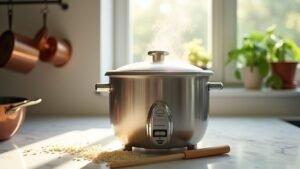Just as Pandora's box released unforeseen consequences, a rice cooker in the hands of curious children can pose unexpected dangers. I'm here to guide you through the critical aspects of child safety around these common kitchen appliances. As a parent or caregiver, grasping the potential hazards and employing effective strategies to safeguard your little ones is crucial. From scalding steam to hot surfaces, the risks are genuine, but with adequate knowledge and precautions, you can establish a secure cooking environment for your family. Let's delve into how to keep your children safe while still relishing the convenience of your rice cooker.
Table of Contents
ToggleUnderstanding Rice Cooker Hazards
Rice cookers, seemingly innocuous kitchen appliances, can pose significant risks to children if not handled properly. As a parent or caregiver, understanding these hazards is vital to safeguard your family's safety.
The primary danger arises from the hot steam emitted during the cooking process. Rice cookers have vent holes that release scalding steam, which can cause severe burns, especially to children's sensitive skin. The stainless steel pot inside the cooker also becomes extremely hot, presenting another burn risk if touched.
Children are particularly susceptible to these hazards due to their curiosity and lack of awareness. They may be tempted to touch the appliance or peek inside while it's operating, exposing themselves to potential injury.
To reduce these risks, practicing proper handling techniques is necessary. Always keep the rice cooker out of children's reach, and supervise them closely when the appliance is in use. Educate your children about the dangers associated with rice cookers and establish clear safety rules for the kitchen.
Proper Handling Techniques
To ensure child safety around rice cookers, one must master proper handling techniques. I'll guide you through essential practices to prevent burns and maintain a safe cooking environment.
When using a rice cooker, especially a stainless steel rice cooker, always use oven mitts or towels to handle hot components. This precaution is vital to avoid burns from the heated surfaces.
I recommend teaching children to be cautious of the steam produced by the rice cooker, as it can cause severe burns if not respected.
Positioning is key. I advise placing the vent hole of the rice cooker away from where you pick up the lid. This simple adjustment minimizes your exposure to hot steam when opening the cooker.
Remember, proper attention and adherence to safety precautions are your best defenses against burns.
When instructing children on rice cooker use, emphasize the importance of proper handling, especially around hot steam. Demonstrate how to safely open the lid, allowing steam to dissipate before fully removing it.
Teaching Children Kitchen Safety
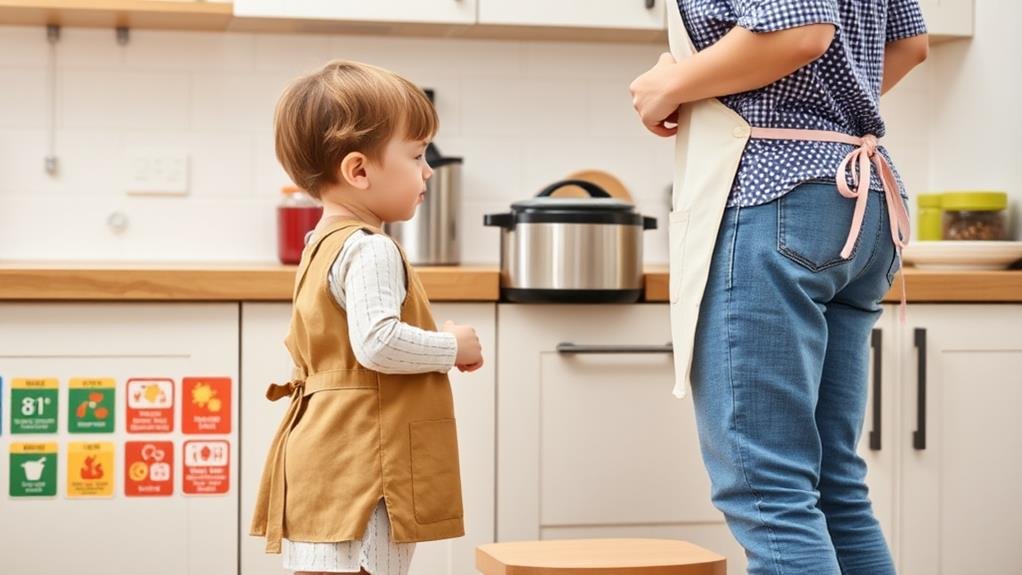
One of the most vital aspects of child safety around rice cookers is teaching children proper kitchen safety. I always emphasize the importance of using oven mitts or towels when handling hot rice cookers, even if they're made of stainless steel. It's essential to educate kids about the dangers of steam produced by these appliances and instruct them to maintain a safe distance to prevent burns.
I make it a point to demonstrate how to position the rice cooker's vent hole away from where the lid is lifted, reducing the risk of steam burns.
Supervision is key when children are around kitchen appliances, so I make sure I'm always present to guide them and reinforce safety guidelines.
Burn Prevention Strategies
Several key strategies can effectively prevent burns when using rice cookers around children.
I'll outline three essential burn prevention strategies to keep your family safe:
- Proper placement: Position the rice cooker on a stable, flat surface away from the edge of countertops and out of children's reach. Make sure the cord isn't dangling where a child might pull it.
- Supervision and education: Always supervise children when the rice cooker is in use. Teach them about the dangers of steam and hot surfaces, emphasizing the importance of maintaining a safe distance.
- Safe handling techniques: Use oven mitts when opening the lid or touching any part of the rice cooker. Open the lid away from your face and body to prevent steam burns.
Supervising Young Chefs
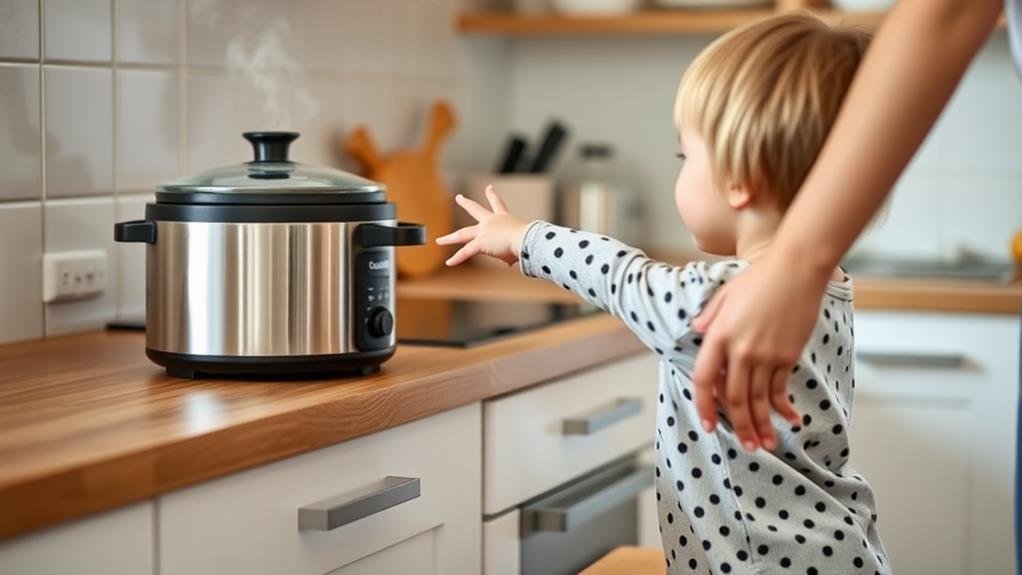
While burn prevention strategies are vital, actively supervising young chefs elevates child safety around rice cookers to the next level. As a parent or guardian, I can't emphasize enough the importance of being present and attentive when children are using kitchen appliances. When it comes to rice cookers, supervising is vital to guarantee proper handling and prevent accidents.
I make it a point to teach children about the potential risks associated with hot appliances, highlighting the need for caution when lifting the rice cooker lid to avoid steam burns. By setting clear safety rules and guidelines, I create a structured environment that promotes safe cooking practices.
This includes proper handling techniques, understanding the appliance's functions, and respecting its potential dangers.
Supervising young chefs isn't just about watching; it's about actively engaging and guiding them through the cooking process. I use this opportunity to reinforce safety habits and encourage responsible behavior in the kitchen.
Safe Cooking Environment Setup
In addition to supervising young chefs, setting up a safe cooking environment is important for child safety around rice cookers. I recommend placing your rice cooker away from the edge of countertops to prevent accidental tipping or burns. It's essential to make sure that cords aren't dangling where children can pull on them, as this can lead to potential hazards.
When not in use, I advise storing your rice cooker in a secure location out of reach of curious children. This precaution is especially important given the materials used in rice cookers, which can retain heat for extended periods.
To further enhance safety, consider implementing these measures:
- Install childproof locks on cabinets storing cooking appliances
- Use non-slip mats under the rice cooker to prevent sliding
- Clearly mark hot surfaces with visible warning signs
I can't stress enough the importance of teaching children about the dangers of hot surfaces and steam from the rice cooker. By educating them early, you're instilling essential safety awareness. Remember, creating a safe cooking environment is an ongoing process that requires constant vigilance and adaptation as your children grow and their abilities change.
Rice Cooker Maintenance Tips
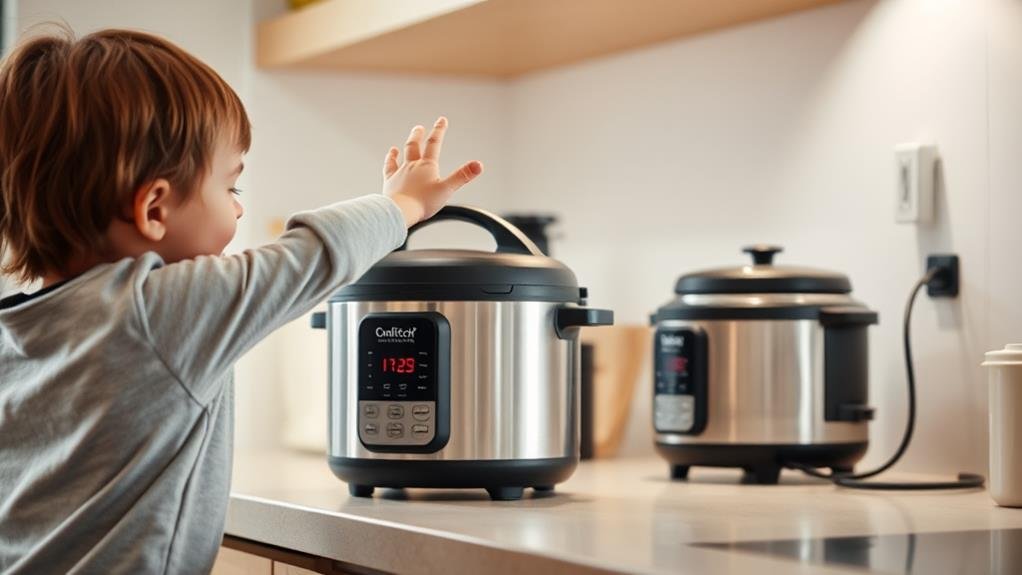
Proper upkeep of your rice cooker is vital for maintaining both safety and peak performance. I suggest establishing a regular cleaning schedule to prevent residue buildup, which can impact cooking quality and pose safety risks.
After each use, thoroughly clean the inner pot, paying special attention to any stuck-on food particles. Avoid using abrasive cleaners or metal utensils that could harm the non-stick coating, as this could result in flaking and potential ingestion of harmful materials.
Regularly inspect the power cord and plug for any signs of wear or damage. If you notice frayed wires or a loose connection, discontinue use immediately and replace the cord or the entire unit if necessary. This step is essential in preventing electrical hazards that could harm your child.
Examine the inner pot, typically made of stainless steel or aluminum, for scratches or dents. These imperfections can compromise the pot's integrity and affect cooking safety. If you spot any damage, consider replacing the inner pot to maintain best performance and safety.
Always follow the manufacturer's instructions for care and maintenance. This ensures you're using appropriate cleaning methods and products, prolonging your rice cooker's lifespan and keeping it safe for your family.
Emergency Response Preparedness
Beyond maintaining your rice cooker, it's crucial to prepare for potential emergencies. Developing a thorough emergency response plan is vital for ensuring your family's safety. This plan should include clear evacuation routes and designated meeting points outside your home. It's essential to keep emergency contact numbers readily accessible and teach your children how to dial them in case of an emergency.
Regular practice of fire drills is crucial to ensure everyone in your household knows exactly what to do if a fire occurs. Additionally, store a first aid kit in an easily accessible location and make sure all family members are familiar with its contents and usage.
To enhance your emergency preparedness, consider implementing these steps:
- Create a detailed floor plan of your home, marking all possible exits
- Install smoke detectors on every floor and test them monthly
- Teach children how to safely exit the house in various emergency scenarios
Age-Appropriate Cooking Tasks
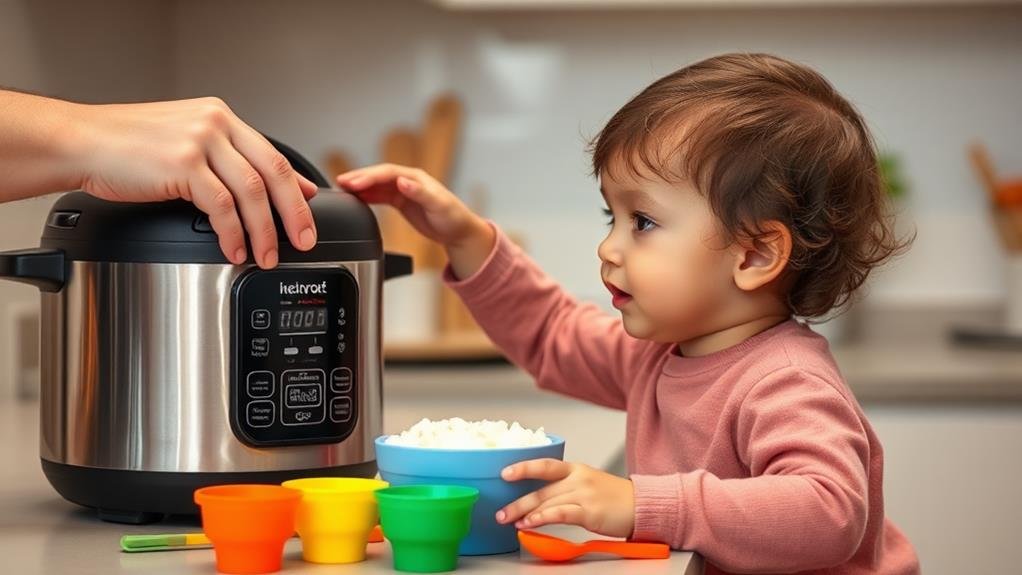
Assigning age-appropriate tasks is necessary when involving children in rice cooker use. For younger children, I suggest simple tasks like measuring ingredients or pressing buttons. These activities allow them to participate safely while learning basic kitchen skills. Older kids can take on more responsibility, such as pouring water or stirring rice before cooking.
Supervision is vital when children are around rice cookers. I always ensure close monitoring, especially when hot surfaces or steam are involved. By teaching kids the importance of following safety guidelines, we can prevent accidents and foster independence in the kitchen.
To help you understand age-appropriate tasks, I've created this table:
| Age Group | Recommended Tasks | Safety Considerations |
|---|---|---|
| 3-5 years | Measure dry rice | Adult supervision |
| 6-8 years | Press buttons | Teach proper technique |
| 9-11 years | Pour water | Monitor closely |
| 12-14 years | Stir rice | Emphasize caution |
| 15+ years | Complete process | Reinforce safety rules |
Conclusion
I've emphasized the critical nature of child safety around rice cookers, much like a vigilant lighthouse guarding against rocky shores. By implementing proper handling techniques, educating children, and maintaining a safe cooking environment, we're building a fortress of protection. Remember, supervision is key. Always be prepared for emergencies, and assign age-appropriate tasks. With these measures in place, we're not just cooking rice; we're cultivating a culture of safety that'll serve our families for years to come.



